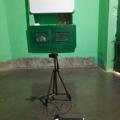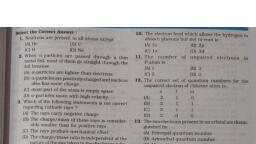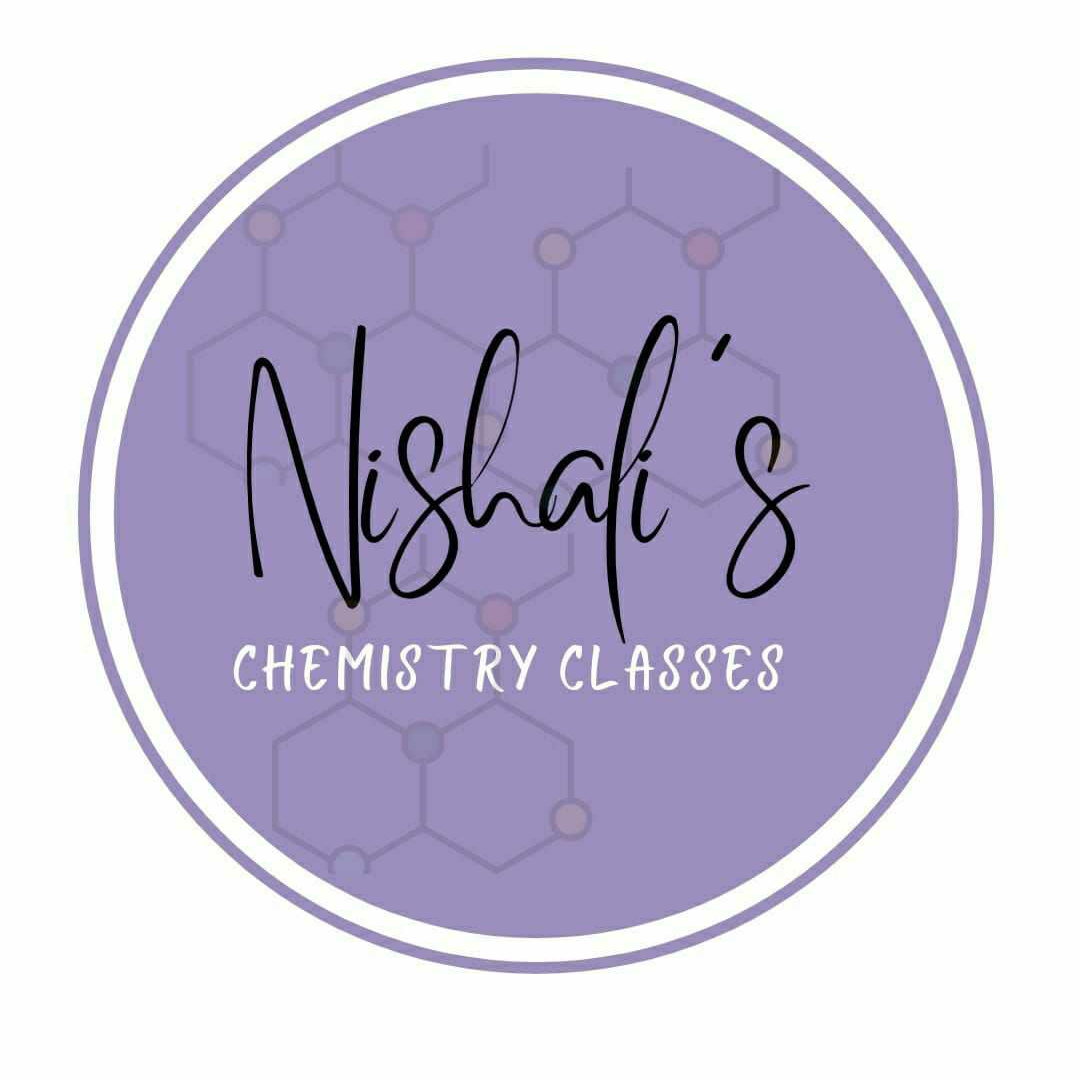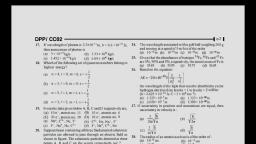Question 1 :
Correct order of radius of the <img style='object-fit:contain' src='https://storage.googleapis.com/teachmint/question_assets/JEE%20Main/5e7980dcd3f9ab617fcdb1d0' height='17' width='11' >st orbit of H, He+, Li2+, Be3+ is :
Question 2 :
Energy of an electron is given by {tex} \mathrm { E } = - 2.178 \times 10 ^ { - 18 } \mathrm { J } \left( \frac { Z ^ { 2 } } { n ^ { 2 } } \right) {/tex}<br>Wavelength of light required to excite an electron in an hydrogen atom from level {tex} n = 1 {/tex} to {tex} n = 2 {/tex} will be :<br>{tex} \left( \mathrm { h } = 6.62 \times 10 ^ { - 34 } \mathrm { J } \mathrm { s } \text { and } \mathrm { c } = 3.0 \times 10 ^ { 8 } \mathrm { ms } ^ { - 1 } \right) {/tex}
Question 3 :
Which of the following conclusions regarding the structure of atom is based on Rutherford's <img style='object-fit:contain' src='https://storage.googleapis.com/teachmint/question_assets/JEE%20Main/5e78e374630b1e60d8656da9' height='15' width='15' >- particle scattering experiment?
Question 4 :
Which of the following represents the correct set of the four quantum numbers of 4{tex} d {/tex} -electrons?
Question 5 :
The highest excited state that an unexcited hydrogen atom can reach when they are bombarded with 12.2 eV electron is:
Question 10 :
How many {tex} 3 \mathrm { d } {/tex} electrons can have spin quantum number {tex} - \frac { 1 } { 2 } ? {/tex}
Question 12 :
The de Broglie wavelength of a tennis ball of mass {tex} 60\ \mathrm { g } {/tex} moving with a velocity of {tex} 10{/tex} metres per second is approximately <br> Plank's constant, {tex}h {/tex}={tex} 6.63 \times 10^{-34} Js {/tex}
Question 13 :
An electron in excited hydrogen atom falls from fifth energy level to second energy level. In which of the following regions, the spectrum line will be observed and is part of which series of the atomic spectrum?
Question 14 :
The frequency of yellow light having wavelength 600 nm is -
Question 15 :
Which one of the following constitutes a group of the isoelectronic species?
Question 16 :
Which atom (X) is indicated by the following configuration?<br><img style='object-fit:contain' src='https://storage.googleapis.com/teachmint/question_assets/JEE%20Main/5e78e36d0009445fe19ceb83' height='24' width='101' >
Question 18 :
If proton, electron and α - particle have equal kinetic energy, their de-Broglie wavelengths would be in the order -
Question 19 :
Splitting of spectral lines under the influence of magnetic field is called
Question 20 :
The frequency of a wave is 6 × 10<sup>15</sup> s<sup>-1</sup>. Its wave number would be
Question 23 :
S1 : Bohr model is applicable for Be2+ ion.<br>S<sub>2</sub> : Total energy coming out of any light source is integral multiple of energy of one photon.<br>S<sub>3</sub> : Number of waves present in unit length is wave number.<br>S4 : e/m ratio in cathode ray experiment is independent of the nature of the gas.
Question 24 :
Which of the following properties of atom could be explained correctly by Thomson model of atom?
Question 25 :
An atom of an element contains 11 electrons. Its nucleus has 13 neutrons. Find out the atomic number and approximate atomic weight.
Question 26 :
Which one of the following groupings represents a collection of isoelectronic species ?{tex} ( \text { At. nos.: } \mathrm { Cs } : 55 , {/tex} {tex} \mathrm { Br } : 35 ) {/tex}
Question 27 :
Effective nuclear charge (<img style='object-fit:contain' src='https://storage.googleapis.com/teachmint/question_assets/JEE%20Main/5e78e3a2630b1e60d8656e17' height='21' width='33' >)for a nucleus of an atom is defined as.
Question 28 :
The momentum of a photon having frequency 1.0 × 10<sup>15</sup> s<sup>-1</sup> is about
Question 29 :
The uncertainty in the momentum of an electron is 1.0 × 10-5 kg m s-1 . The uncertainty in its position will be:
Question 30 :
Which of the following is responsible to rule out the existence of definite paths or trajectories of electrons?
Question 31 :
Describe the orbital with following quantum numbers: <br>(i) n = 3, l = 2 (ii) n = 4, l = 3
Question 32 :
Which experiment is responsible for finding out the charge on an electron?
Question 33 :
The energy required to break one mole of {tex} \mathrm { Cl } - \mathrm { Cl } {/tex} bonds in {tex} \mathrm { Cl } _ { 2 } {/tex} is {tex}242\ \mathrm { kJ } \mathrm { mol } ^ { - 1 } {/tex} . The longest wavelength of light capable of breaking a single {tex} \mathrm { Cl } - \mathrm { Cl } {/tex} bond is<br>{tex} \left( c = 3 \times 10 ^ { 8 } \mathrm { ms } ^ { - 1 } \text { and } N _ { A } = 6.02 \times 10 ^ { 23 } \mathrm { mol } ^ { - 1 } \right) {/tex}<br>
Question 35 :
____ Series of lines are the only lines in hydrogen spectrum which appear in the visible region.
Question 36 :
In a multi-electron atom, which of the following orbitals described by the three quantum numbers will have the same energy in the absence of magnetic and electric field ?<br>(i) n = 1, l = 0, m = 0 (ii) n =2, l = 0, m = 0 (iii) n = 2, l = 1, m = 1 (iv) n = 3, l = 2, m =1 (v) n = 3, l = 2, m = 0
Question 37 :
The ionisation energy of a hydrogen atom in terms of Rydberg constant {tex} \left( R _ { H } \right) {/tex} is given by the expression
Question 38 :
If the value of En = - 78.4 kcal/mole, the order of the orbit in hydrogen atom is :
Question 39 :
The species which has its fifth ionisation potential equal to 340 V is
Question 40 :
The particle used by Rutherford in $\alpha$-ray scattering experiment was :
Question 41 :
The wavelength of a charged particle ________the square root of the potential difference through which it is accelerated
Question 43 :
If threshold wavelength (λ°) for ejection of electron from metal is 330 nm, then work function for the photoelectric emission is -
Question 44 :
The fourth line of the Balmer series corresponds to electron transition between which energy levels
Question 45 :
What will be orbital angular momentum of an electron in 2 s - orbital?


















































